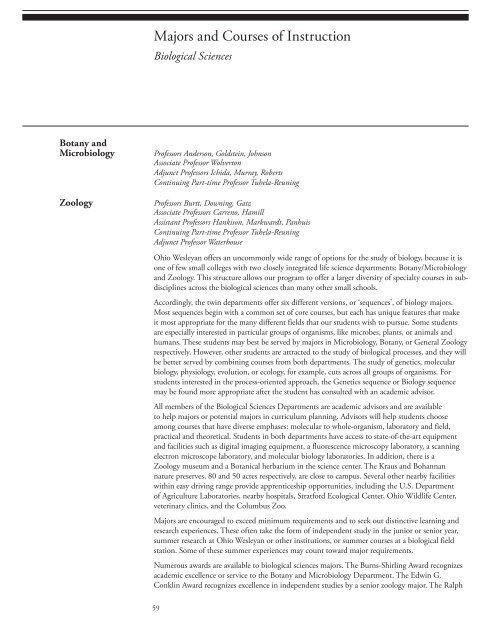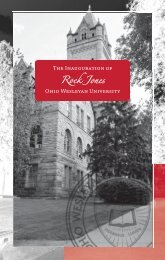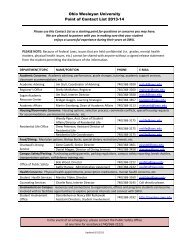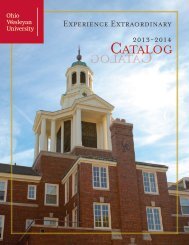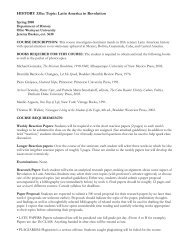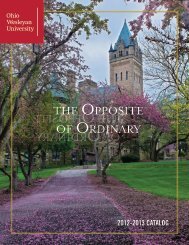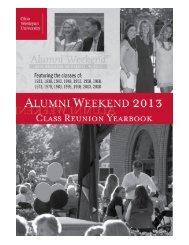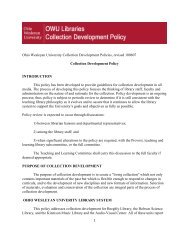- Page 3 and 4:
2011/2012 CatalogOhio Wesleyan Univ
- Page 7 and 8:
The UniversityIntroductionIntroduct
- Page 9 and 10:
The UniversityIntroductionStatement
- Page 11 and 12:
The UniversityIntellectual Freedom
- Page 13: The UniversityTraditionsMonnett Cam
- Page 19 and 20: Academic RegulationsAnd ProceduresR
- Page 21 and 22: Academic RegulationsAnd ProceduresR
- Page 23 and 24: Academic RegulationsAnd ProceduresA
- Page 25 and 26: Academic RegulationsAnd ProceduresA
- Page 27 and 28: Academic RegulationsAnd ProceduresA
- Page 29 and 30: Academic RegulationsAnd ProceduresF
- Page 31: Academic RegulationsAnd ProceduresT
- Page 34 and 35: Academic Honors and PrizesHonors Co
- Page 36 and 37: Academic Honors and PrizesPrizes an
- Page 38 and 39: Academic Honors and PrizesPrizes an
- Page 40 and 41: Academic Honors and PrizesPrizes an
- Page 42 and 43: Academic Honors and PrizesHonorary
- Page 44 and 45: Degrees and Special ProgramsRequire
- Page 46 and 47: Degrees and Special ProgramsThe Bac
- Page 48 and 49: Degrees and Special ProgramsThe Bac
- Page 50 and 51: Degrees and Special ProgramsOther P
- Page 52 and 53: Degrees and Special ProgramsOff-Cam
- Page 54 and 55: Degrees and Special ProgramsInterna
- Page 56 and 57: Degrees and Special ProgramsApprent
- Page 59 and 60: Majors and Courses of InstructionKe
- Page 61 and 62: Majors and Courses of InstructionAn
- Page 63: Majors and Courses of InstructionAn
- Page 67 and 68: Majors and Courses of InstructionBi
- Page 69 and 70: Majors and Courses of InstructionBi
- Page 71 and 72: Majors and Courses of InstructionBi
- Page 73 and 74: Majors and Courses of InstructionBi
- Page 75 and 76: Majors and Courses of InstructionBi
- Page 77 and 78: Majors and Courses of InstructionBl
- Page 79 and 80: Majors and Courses of InstructionBl
- Page 81: Majors and Courses of InstructionBl
- Page 84 and 85: Majors and Courses of InstructionCh
- Page 86 and 87: Majors and Courses of InstructionCh
- Page 88 and 89: Majors and Courses of InstructionPr
- Page 90 and 91: Major Courses of InstructionEast As
- Page 93 and 94: Majors and Courses of InstructionEc
- Page 95 and 96: Majors and Courses of InstructionEc
- Page 97 and 98: Majors and Courses of InstructionEc
- Page 99 and 100: Majors and Courses of InstructionEc
- Page 101 and 102: Majors and Courses of InstructionEc
- Page 103 and 104: Majors and Courses of InstructionEc
- Page 105 and 106: Majors and Courses of InstructionAc
- Page 107 and 108: Majors and Courses of InstructionEd
- Page 109 and 110: Majors and Courses of InstructionEd
- Page 111 and 112: Majors and Courses of InstructionEd
- Page 113 and 114: Majors and Courses of InstructionEd
- Page 115 and 116:
Majors and Courses of InstructionEd
- Page 117 and 118:
Majors and Courses of InstructionEn
- Page 119 and 120:
Majors and Courses of InstructionEn
- Page 121 and 122:
Majors and Courses of InstructionEn
- Page 123 and 124:
Majors and Courses of InstructionEn
- Page 125 and 126:
Majors and Courses of InstructionEn
- Page 127 and 128:
Majors and Courses of InstructionEn
- Page 129:
Majors and Courses of InstructionEn
- Page 132 and 133:
Majors and Courses of InstructionFi
- Page 134 and 135:
Majors and Courses of InstructionFi
- Page 136 and 137:
Majors and Courses of InstructionFi
- Page 138 and 139:
Majors and Courses of InstructionFi
- Page 140 and 141:
Majors and Courses of InstructionGe
- Page 142 and 143:
Majors and Courses of InstructionGe
- Page 144 and 145:
Majors and Courses of InstructionGe
- Page 146 and 147:
Majors and Courses of InstructionGe
- Page 148 and 149:
Majors and Courses of InstructionGe
- Page 150 and 151:
Majors and Courses of InstructionGe
- Page 152 and 153:
Major Courses of InstructionHistory
- Page 154 and 155:
Major Courses of InstructionHistory
- Page 156 and 157:
Major Courses of InstructionHistory
- Page 158 and 159:
Major Courses of InstructionHistory
- Page 161 and 162:
Majors and Courses of InstructionHu
- Page 163 and 164:
Majors and Courses of InstructionHu
- Page 165 and 166:
Majors and Courses of InstructionHu
- Page 167 and 168:
Majors and Courses of InstructionHu
- Page 169 and 170:
Majors and Courses of InstructionHu
- Page 171 and 172:
Majors and Courses of InstructionIn
- Page 173:
Major Courses of InstructionInterna
- Page 176 and 177:
Majors and Courses of InstructionJo
- Page 179 and 180:
Majors and Courses of InstructionLa
- Page 181 and 182:
Majors and Courses of InstructionMa
- Page 183 and 184:
Majors and Courses of InstructionMa
- Page 185 and 186:
Majors and Courses of InstructionMa
- Page 187 and 188:
Majors and Courses of InstructionMa
- Page 189 and 190:
Majors and Courses of InstructionMo
- Page 191 and 192:
Majors and Courses of InstructionMo
- Page 193 and 194:
Majors and Courses of InstructionMo
- Page 195 and 196:
Majors and Courses of InstructionMo
- Page 197 and 198:
Majors and Courses of InstructionMo
- Page 199 and 200:
Majors and Courses of InstructionMo
- Page 201 and 202:
Majors and Courses of InstructionMo
- Page 203:
Majors and Courses of InstructionMo
- Page 206 and 207:
Majors and Courses of InstructionMu
- Page 208 and 209:
Majors and Courses of InstructionMu
- Page 210 and 211:
Majors and Courses of InstructionMu
- Page 212 and 213:
Majors and Courses of InstructionMu
- Page 214 and 215:
Majors and Courses of InstructionMu
- Page 217 and 218:
Majors and Courses of InstructionPh
- Page 219 and 220:
Majors and Courses of InstructionPh
- Page 221 and 222:
Majors and Courses of InstructionHe
- Page 223 and 224:
Majors and Courses of InstructionHe
- Page 225 and 226:
Majors and Courses of InstructionHe
- Page 227 and 228:
Majors and Courses of InstructionHe
- Page 229:
Majors and Courses of InstructionHe
- Page 232 and 233:
Majors and Courses of InstructionPh
- Page 234 and 235:
Majors and Courses of InstructionPh
- Page 236 and 237:
Majors and Courses of InstructionPh
- Page 239 and 240:
Majors and Courses of InstructionPo
- Page 241 and 242:
Majors and Courses of InstructionPo
- Page 243 and 244:
Majors and Courses of InstructionPo
- Page 245 and 246:
Majors and Courses of InstructionPo
- Page 247 and 248:
Majors and Courses of InstructionPr
- Page 249 and 250:
Majors and Courses of InstructionPs
- Page 251 and 252:
Majors and Courses of InstructionPs
- Page 253 and 254:
Majors and Courses of InstructionPs
- Page 255 and 256:
Majors and Courses of InstructionPs
- Page 257 and 258:
Majors and Courses of InstructionRe
- Page 259 and 260:
Majors and Courses of InstructionRe
- Page 261 and 262:
Majors and Courses of InstructionRe
- Page 263:
Majors and Courses of InstructionRe
- Page 266 and 267:
Majors and Courses of InstructionSo
- Page 268 and 269:
Majors and Courses of InstructionSo
- Page 270 and 271:
Majors and Courses of InstructionSo
- Page 272 and 273:
Majors and Courses of InstructionTh
- Page 274 and 275:
Majors and Courses of InstructionTh
- Page 276 and 277:
Majors and Courses of InstructionTh
- Page 278 and 279:
Majors and Courses of InstructionTh
- Page 280 and 281:
Majors and Courses of InstructionWo
- Page 282 and 283:
Majors and Courses of InstructionWo
- Page 284 and 285:
Majors and Courses of InstructionWo
- Page 287 and 288:
Expenses and Financial AidTuition a
- Page 289 and 290:
Expenses and Financial AidFeesIf th
- Page 291 and 292:
Expenses and Financial AidFeesCable
- Page 293 and 294:
Expenses and Financial AidPayment M
- Page 295 and 296:
Expenses and Financial AidLibraries
- Page 297 and 298:
FacilitiesInstructional and Adminis
- Page 299:
FacilitiesInstructional and Adminis
- Page 302 and 303:
The Corporation (Board of Trustees)
- Page 304 and 305:
University PersonnelOffice of the P
- Page 306 and 307:
University PersonnelOffice of the P
- Page 308 and 309:
University PersonnelStudent Affairs
- Page 310 and 311:
University PersonnelAdjunct Faculty
- Page 312 and 313:
University PersonnelFaculty and Sta
- Page 314 and 315:
University PersonnelFaculty of Inst
- Page 316 and 317:
University PersonnelFaculty of Inst
- Page 318 and 319:
University PersonnelFaculty of Inst
- Page 320 and 321:
University PersonnelFaculty of Inst
- Page 323 and 324:
IndexAabbreviations 53abroad 1, 28,
- Page 325 and 326:
IndexJjapanese 40, 47, 53, 84, 92,
- Page 327 and 328:
Ohio Wesleyan University Calendar 2


